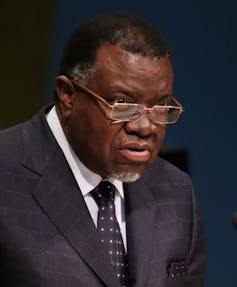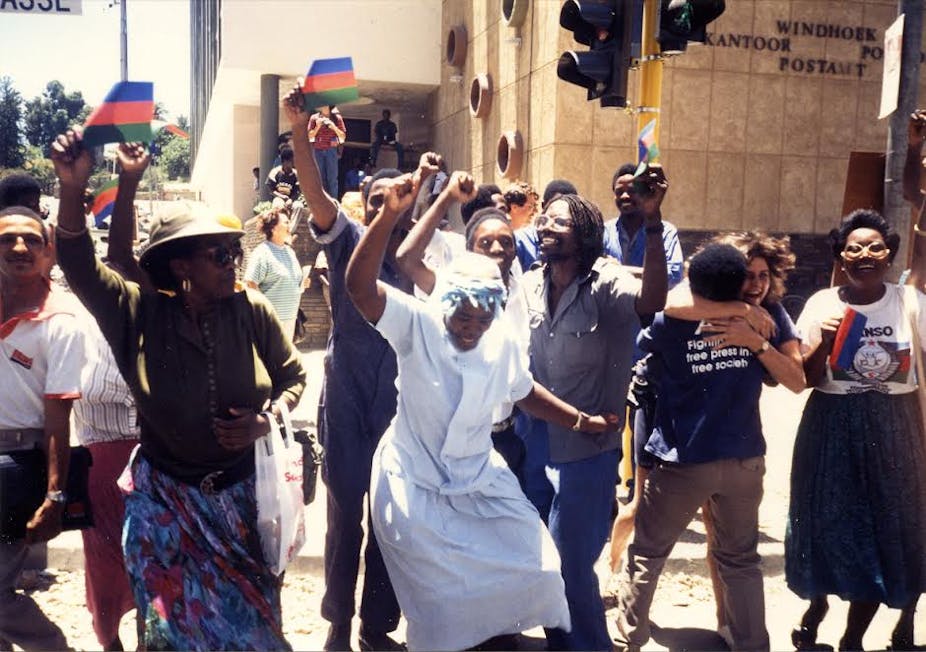Visitors to “the land of wide open spaces”, as Namibia is successfully promoted to tourists, will be impressed by what they see. Besides the beauty of the nature and abundant wildlife, the urban face of inner cities appeals to foreigners who treasure security and comfort amid the wilderness.
Namibia contributes a positive image to Africa. It ranks among the continent’s top five in governance and other performance related surveys. But beyond the surface of the success story looms a different reality for most of the country’s 2.3 million people, as it marks 27 years of independence.
Independence was finally achieved on March 21, 1990 after a long and violent anti-colonial struggle. Since then, Namibia has shown remarkable signs of political stability. The former liberation movement Swapo governs with an ever-increasing majority.
It secured 80% of votes in the last parliamentary elections. The directly elected party candidate for head of state, Hage Geingob, scored almost 87%. Still representing the first generation of the liberation struggle, he personifies the smooth succession of three post-independence state presidents with far reaching executive powers.
Catchwords attributed to them by party propaganda include reconciliation (Sam Nujoma, 1990-2005), consolidation (Hifikepunye Pohamba, 2005-2015) and prosperity (Hage Geingob, since 2015. Geingob is the party’s vice-president and became acting president in April 2015.
But under his presidency the promised prosperity has remained the privilege of few. Namibia is a rich country with poor people. Redistribution of wealth is mainly limited to beneficiaries within a new black elite. These are office bearers, party stalwarts and those with close ties to the new inner circles of governance. They thrive through a policy of so-called affirmative action and black economic empowerment.
A new terminology refers to “fat cats”, “tenderpreneurs” and “sight holders”. These labels reflect the continued exploitative nature of the economic realities.
Namibia’s state-driven economy
Namibia’s state-driven economy is a paradise for parasitic and rent-seeking self-enrichment schemes. The creation of state-owned enterprises as troughs for embezzlement has flourished. State tenders have dished out large sums for projects bordering on megalomaniac elite symbolism, often without creating any meaningful productive assets. Nepotism is a striking feature of a society with one of the highest income discrepancies in the world.
The UNDP’s Human Development Report documents the gross inequalities. A commonly referred to statistical figure is the country’s Gross National Income distribution per capita. This categorises Namibia as a higher middle-income country. But this number is misleading.
The inequality adjusted Human Development Index shows that Namibia has one of the highest inequalities in the world as measured by a Gini coefficient 0.613.
Also, 23.5% of the population was classified as living below the income poverty line using 2013 data.
Namibia’s government claims to have achieved considerable poverty alleviation. This contrasts sharply with the data. If tourists would end up in some of the overpopulated shack settlements at the outskirts of Namibian towns, they would see a different world from the lodges and Windhoek’s inner city.
Economic mismanagement
Namibia’s government is not shy of self-appraisals. It’s fond of blueprints, strategies and programmes, all claiming to solve the country’s problems. Under President Geingob, a new Ministry of Poverty Eradication and Social Welfare had been established. But so far little has been achieved.
The country’s fourth National Development Plan has been complemented by a Harambee Prosperity Plan. It’s based on an annual economic growth rate of at least 7%. Given the (un)predictable insecurities such as global economic shocks, the effects of climate change, and the devastating consequences of the recent drought, this borders on wishful thinking similarly set out in Vision 2030. This claims that by then “Namibia will be a prosperous and industrialised nation”.
In reality, Namibia’s economy has been in recession since mid-2016.
The discrepancy between promises and realities suggests that President Geingob’s rhetoric borders on populism. The ritual of declaring the annual state budget as “pro-poor” has long lost any convincing effect.
Expenditure for army, police and security related portfolios have over the years proportionally increased more than other expenditure. So have debt services for local and foreign loans.

The hope for an economic recovery in the near future is pinned on a booming tourism sector and the full production of one of the biggest uranium mines in the world owned by a Chinese company. Such silver linings look rather bleak and faint. Sustainability would require other ingredients, not least a meaningful increase of employment.
But as of mid-2016, the state’s finances have faced a precarious shortage. The annual budget for 2017/2018 reflects the need to restore fiscal prudence and austerity to regain liquidity and some degree of credibility. Local trust and confidence in the state’s ability to deliver is at an all-time low.
A contentious issue is the bloated civil service. More than 20 years ago a wage and salary commission urged then Prime Minister Hage Geingob to stop recruitment in the public sector. But the expansion continued unabated.
The political elite continues to preach water and drink wine: a year ago President Geingob signed a 6% salary increase with immediate effect for all political office holders. His cabinet is by far the biggest since independence.
Grown up, but not mature
Despite shifting grounds, the party still mobilises along the heroic narrative of the liberation struggle, much to the frustration of a younger generation. But the number of born frees with voting rights will soon exceed the older generations. Inner-party rivalries and tensions, as well as ethnicity as a potential source of conflict are on the rise. An unresolved land issue, also manifested in urban and ancestral land claims, is adding fuel to the flames.
Dissenting voices, mainly articulated by vocal younger activists provoke government to consider plans to censor the social media. A whistleblower bill before parliament includes provisions to heavily punish “lies” and to prohibit any criticism of state institutions. It restricts public opinion, including intimidation of the remarkably free and critical independent print media.
The authoritarian if not totalitarian tendency is also documented in Swapo’s current initiatives to take disciplinary action against members who dare to criticise party politics. But this will not silence the growing frustration over the limits to liberation.
Nor does the close collaboration with North Korea add any positive image. A planned visit by the pariah state’s foreign minister was cancelled at the last minute after news about it leaked in the media.
A generation into independence, the country and its governance might be considered as grown up, but certainly not (yet) mature.

